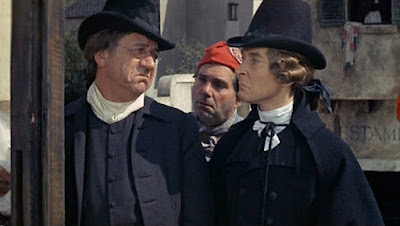Don't Lose Your Head, released in 1966, was the thirteenth of the Carry On films and the first to be distributed by Rank, Anglo-Amalgamated having dropped the series because its new managing director disliked them. Rank initially planned to drop the Carry On prefix from the titles but soon changed their minds when they discovered that the Carry On name was a major drawcard. Don't Lose Your Head was later retitled Carry On...Don’t Lose Your Head and released in the US as Carry On Pimpernel.
The film is obviously a spoof of The Scarlet Pimpernel but since he did not have the rights to Baroness Orczy’s books producer Peter Rodgers somehow managed to convince her estate that the movie had nothing whatever to do with the Scarlet Pimpernel!
The movie is set during the Terror in Paris, with French aristocrats being slaughtered en masse. The man in charge of the executions is the implacable Citizen Camembert (Kenneth Williams), assisted by the bumbling Citizen Bidet (Peter Butterworth). Two bored foppish English noblemen, Sir Rodney Ffing (Sid James) and Lord Darcy Pue (Jim Dale), decide to do something about this. Soon the Black Fingernail is rescuing French aristocrats from under the very nose of Citizen Camembert.
While rescuing the Duc de Pommfrit (Charles Hawtrey) from the guillotine Sir Rodney meets and falls in love with the beautiful Jacqueline (Dany Robin). Citizen Camembert intends to use Jacqueline as bait in a trap to capture the Black Fingernail, but first they must learn his identity. Camembert and Bidet set off for England in order to discover this essential fact, along with Camembert’s mistress Désirée Dubarry (Joan Sims). Camembert travels in disguise as a French aristocrat. While Camembert tries to trap the Black Fingernail the Black Fingernail is trying to trap him.
Having an actual plot helps things along. And being a spoof of swashbuckling adventures this movie has more action than previous Carry On films. The action scenes combine actual action with (naturally) lots of visual humour and the combination works very well. The movie ends with a long and remarkably ambitious action set-piece which is not only funny but a pretty decent swashbuckling adventure fight scene into the bargain.
The script is of course packed to overflowing with double entendres. Talbot Rothwell had by this time become the regular writer for the series and this is typical of the fine scripts he provided during this period.
The best of the Carry On movies were, in my opinion, those with historical settings. They tended to look rather more opulent than those with contemporary settings and somehow the distinctive Carry On humour seems to work best in period costume. Of course the historical Carry Ons also tended to have stronger plot lines which gave them a bit more discipline and this in turn seemed to make the outrageous acting performances even funnier.
Don't Lose Your Head is actually quite lavish visually with some attractive location shooting and (by low-budget movie standards) some truly sumptuous costumes and sets. And Alan Hume’s cinematography is impressive, especially given the very tight shooting schedule.
The genius of producer Peter Rogers was his ability to achieve fairly high production valuers while keeping budgets very low. Rogers’ financial tight-fistedness caused some tensions with cast members who felt they should have been paid more but the low budgets were essential to the success of the series since they more or less guaranteed that the films would always turn a profit.
This entry in the cycle features most of the regulars and they’re all in splendid form. It would be quite unfair to pick out any one performance as a standout - by this time the regular Carry On repertory company was functioning like a well-oiled machine and it’s the teamwork that provides the magic.
The ITV Studios Home Entertainment Carry On Complete Collection DVD boxed set includes all the Carry On movies plus the short-lived Carry On Laughing TV series. The anamorphic transfer for Don't Lose Your Head is impressive and extras include a commentary track with star Jim Dale.
Don't Lose Your Head has always been one of my favourite Carry On movies. It looks great, it’s delightfully funny and as a bonus it has some fun action scenes. It’s a thoroughly enjoyable swashbuckling romp with the characteristic cheerfully but innocently risque Carry On verbal humour. Highly recommended.

























